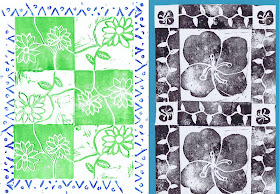If there’s something strange in your neighborhood…
If there’s something weird and it don’t look good
Who you gonna call? Ghostbusters!
Yeah, it’s that time of year when strange things may be seen in your neighborhood, but instead of calling Ghostbusters, I will, of course, pin my faith on etymology. Here are a handful of interesting origins for some of English’s many ways of referring to the strange and uncanny…
strange - The different meanings of strange in the English language continue to coexist (as illustrated by the Doors’ “People are strange when you’re a stranger…”) We can still talk about strange meaning “foreign or unfamiliar” (our original, late 13th century meaning, from French, from Latin) while about a century later we gained the meaning “queer, surprising.” The shift from one meaning to the other is pretty straightforward, too. Think of the word outlandish, by way of comparison. But some of our other odd words are a little odder.
odd - In Old Norse the word oddi began as a triangle, shifted to refer to the unmatched point of an isosceles triangle, and the points of other things, such as spearheads and promontories, and also the extra number or object in excess of an even set. For example, the odd man breaks a tie in voting. English borrowed the word with this meaning around 1300, where it took around a century to gain the sense of “rare, special.” Think of the similar two senses of singular, by way of comparison. The concept of the “odd one out” led eventually to our “strange, peculiar” meaning around 1580.
weird - In Old English wyrd was a noun meaning “fate, destiny.” By Shakespeare’s time the word was pretty much extinct, having been replaced by Latinate words. It did remain, however, in Scots dialects, meaning a witch (one who controls people’s fates), and appearing most commonly in the phrase “the weird sisters,” meaning the Fates in the classical sense, but generally thought of as hideous, uncanny witches. That’s how Shakespeare found the word when he was raiding Holinshed’s Chronicles of England, Scotlande, and Irelande for plots. From the strange spellings in the First Folio of Macbeth, it’s actually unclear whether Shakespeare understood the word’s real meaning or just borrowed it willy-nilly. At any rate, as time went on and the only place English speakers ever encountered this uncommon word was to describe the three ghastly, deformed, supernatural witches in productions of Shakespeare’s play, they interpreted it accordingly. Thus by the early 19th century the word had gained new life and currency, but with the meaning “strange (adj),” instead of “fate (n).”
bizarre - A more recent addition to English (around 1640), borrowed from French, which borrowed it from Italian. The Italian bizarro meant “irascible, tending to quick flashes of anger,” which shifted toward “unpredictable” and thence to “strange.”
peculiar - A prime example of an Inkhorn Term, English gained this word in the mid 15th century from Latin “private property,” literally “property in cattle.” In English it first meant “belonging exclusively to one person,” but it wasn’t long before it gained the sense of “special,” and from there shifted to “unusual.”
What’s kind of fun about these words is that they all began in different places, and converged over the centuries on the sense of… well, weird. It’s interesting that we seem to keep adapting new words to try to get at that meaning from all different directions. After all, isn’t weird almost by definition the stuff that’s hard to describe or explain? But the beauty of language and its essentially social nature is that no matter how hard it is to talk about something, we never stop trying.
[Pictures: Macbeth and Banquo meet the Weird Sisters, woodcut from Chronicles of England, Scotlande, and Irelande by Raphael Holinshed, 1577 (Image from the Folger Shakespeare Library);
Choleric Men Drinking (i.e. bizarro), woodcut by Erhard Schön, c. 1530 (Image from Quadriformisration).]
























